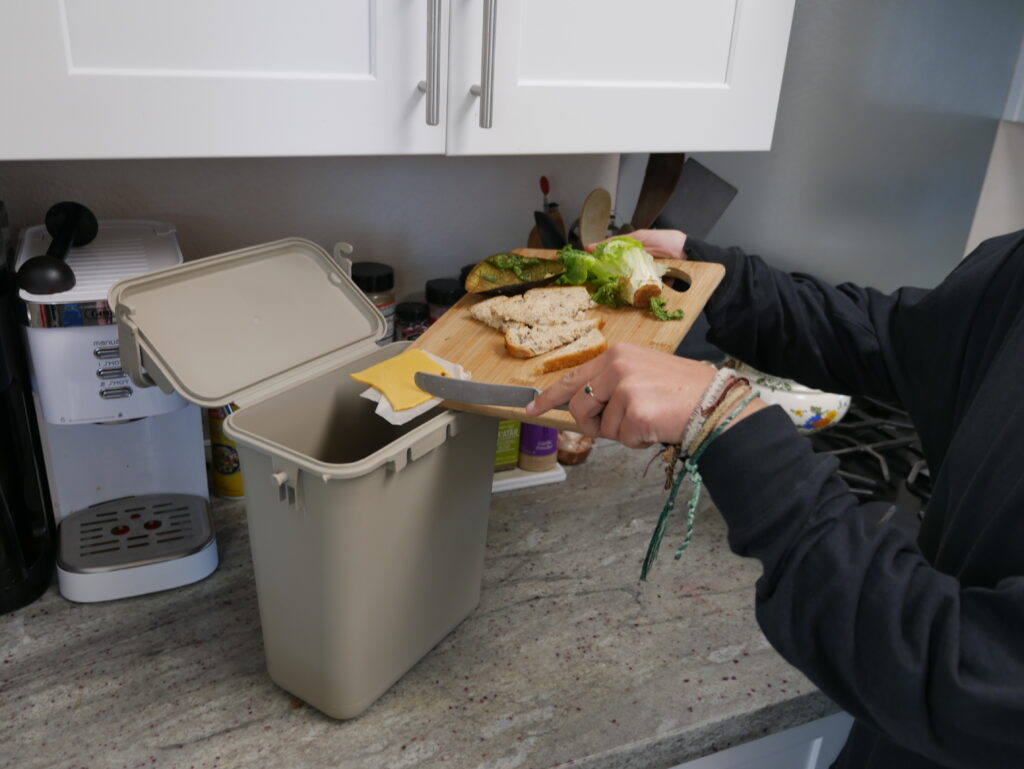Solutions for Managing Food Waste From the Kitchen Counter to the Curb

In California, the term “green bin” has become ubiquitous with the rollout of SB 1383 organics recycling regulations that went into effect in 2022. As we look to January 2024, a new phase of the state bill will be seen with the enforcement of non-compliant businesses and jurisdictions. This is great news for those dedicated to edible food rescue and diverting organic material from the landfill to prevent climate-warming greenhouse gases.


Many jurisdictions have supplied their residents with curbside green curbside bins, as well as kitchen scraps caddy containers, such as the ones pictured above, intended to easily contain food scraps until residents are ready to take them out to the curb. Solana Center has been working in neighborhoods throughout the San Diego region and discussing questions and concerns with residents and business owners about the process of organics recycling. While it may present a slight update in kitchen processes, in all likelihood, organic waste recycling is here for the long haul, so we want to support you as you discover what works best for your household!
What is the best way to get food scraps from your kitchen counter to your curbside green bin?
From concerns about fruit flies and odors to messes and ants, we want to help you get your green waste from point A to point B to be properly recycled! We asked the San Diego County community what has worked well for them and one common thread was discovering what method and approach works best for your household’s waste stream and lifestyle. There is no one-size-fits-all solution but there are many smart techniques and tools your neighbors are using that might just give you some inspiration.

Add a lidded 5-gallon bucket into the mix
Two Solana Center employees have come up with a system of their own in their households: line the bottom of kitchen caddy with newspaper, which helps reduce its odors as it sits on their countertop or under their kitchen sink. Once full, the caddy is emptied into a sealed 5-gallon bucket, also lined with newspaper. They continue adding to this bucket as needed until collection day, when they dump their buckets into their curbside bin. The newspaper prevents sticky residue build up in all containers and ensures your food has minimal time in the green bin to greatly reduce odors inside.
It’s also possible to put your scraps directly into the newspaper- or cardboard-lined bucket, to dump into your green dumpster when full! The airtight lid keeps pests out, while the larger size keeps you from too many trips to the dumpster. Used buckets are available for $10 each ($15 cheaper than a new bucket!) at the Solana Center store.
Skip the caddy and use a big container instead
A family of three in the Kensington area have skipped the kitchen caddy altogether, and use their large empty plastic wide-mouth jars (such as one from protein powder, collagen, etc.) instead. They store it on the kitchen counter, and since it has a screw-top and fully seals, it releases no odors except very briefly when opened to add scraps. They’ve found this container empties and cleans easily, ready to be used again! A big Tupperware container or something else with a lid can be used in the same way.
Freeze your scraps before they hit the curb
An Encinitas couple has started freezing their food scraps wrapped in newspaper or paper bags. The scraps remain in the freezer until either the evening before or the morning of collection day, when the bag is tossed in the curbside bin. For scraps that have more liquid in them, they stick the wrapped scraps into a spare food storage container before freezing. This has completely eliminated odors both in the kitchen and in their curbside bin, as well as the mess of any sticky or greasy materials.
Getting set up for success with your green bin
We hope to help you find ways to make SB 1383 organics recycling regulations work for your family. As you can see from the people we chatted with, every family and every household has found their own system that works for their needs, available spaces, and desired outcomes. Here’s to you finding yours!
Questions about how to implement one of the practices discussed in this article, or trying to brainstorm your own system? Give our Rotline a call at (760) 436-7986 x700, or email us at compost@solanacenter.org.
